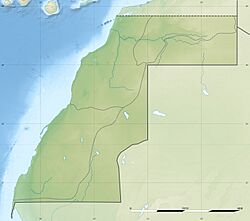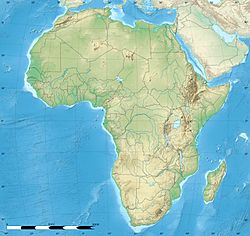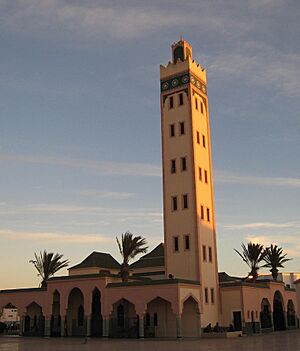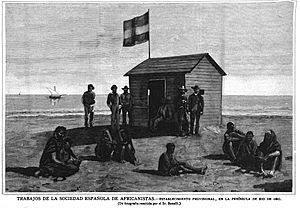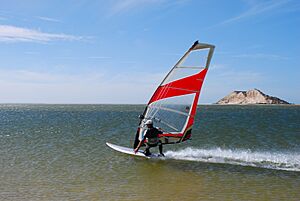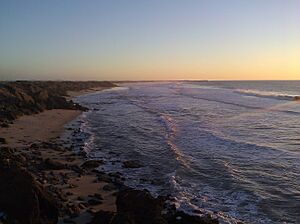Dakhla, Western Sahara facts for kids
Quick facts for kids
Dakhla
الداخلة
|
|
|---|---|
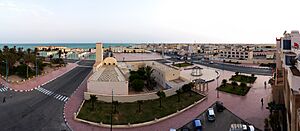 |
|
| Non-self-governing territory | Western Sahara |
| Claimed by | |
| Controlled by | |
| Region | Dakhla-Oued Ed-Dahab |
| Province | Oued Ed-Dahab |
| Area | |
| • Total | 301.45 km2 (116.39 sq mi) |
| Population
(2014)
|
|
| • Total | 106,277 |
| • Density | 352.553/km2 (913.11/sq mi) |
| Time zone | UTC+1 |
Dakhla (which means "The Peninsula" in Arabic) is a city in Western Sahara. This territory is currently controlled by Morocco. Dakhla is the capital of the Moroccan region called Dakhla-Oued Ed-Dahab.
The city has about 106,277 people living there. It is located on a thin strip of land called the Río de Oro Peninsula. This peninsula stretches out into the Atlantic Ocean. Dakhla is about 550 kilometers (340 miles) south of Laayoune.
Contents
A Look Back at Dakhla's History
Early Times in Dakhla
Around the 1100s, the Río de Oro area was settled by the Oulad Delim tribe. These were Arab Bedouin people who came from Yemen.
Later, Spain became interested in this desert coast. Spanish fishers from the nearby Canary Islands often fished here. They also wanted to protect themselves from Barbary pirates.
Spanish fishers hunted seals and whales along the coast from the 1500s. This included areas from Dakhla to Cabo Blanco. Sadly, these activities harmed local wildlife. Many sea mammals and birds disappeared or became endangered.
How Spain Colonized Dakhla
The Spanish set up places for whaling and trading. In 1881, a dock was built near the Río de Oro Peninsula. This helped the fishing boats from the Canary Islands.
In 1884, Spain officially founded a settlement called Villa Cisneros. This name honored Francisco Cardinal Jiménez de Cisneros. He was an important Spanish religious leader.
When the Spanish arrived, they had to work with the Oulad Delim tribe. This tribe controlled the whole Rio de Oro area. In 1884, the Oulad Delim attacked the Spanish trading post. But Spain then declared that the coast from Cape Bojador to Cape Blanc was theirs.
By 1886, Spain's control reached 150 miles inland. They made an agreement with a local Oulad Delim leader. The Spanish military claimed this coast for Spain. They set up three settlements. Villa Cisneros was one of them.
During the time Spain ruled, Dakhla was the capital of the Rio de Oro province. This was one of two regions in what was called Spanish Sahara. The Spanish built a military fort and a church. A prison camp also existed at the fort. Writers like Pedro García Cabrera were held there.
In the 1960s, Spain also built Dakhla Airport. This is one of the three paved airports in Western Sahara. On January 12, 1976, the last Spanish soldier left Dakhla. Spain decided to leave the territory peacefully. This was to avoid a big fight that would have cost many lives.
Between 1975 and 1979, Dakhla was the capital of a Mauritanian province. This was because Mauritania took control of the southern part of Western Sahara. Today, Dakhla Airport is used for civilian flights and by Royal Air Maroc. Its runway is long enough for large planes.
Dakhla Today
Spain controlled Dakhla from the late 1800s until 1975. After that, Morocco and Mauritania shared control. In 1991, the United Nations helped arrange a ceasefire. However, many countries still do not officially recognize Morocco's control over the area.
Recently, several countries have opened consulates in Dakhla. These include The Gambia, Guinea, and the Democratic Republic of the Congo.
As of 2024, Morocco is building a large port in Dakhla. This project is expected to cost $1.2 billion. It is part of Morocco's plan to improve its ports. The port should be finished by 2028.
What Dakhla's Economy Is Like
Tourism and Fun Sports
Dakhla's main ways of making money are fishing and tourism. In recent years, the city has become a popular spot for water sports. People come here for kitesurfing, windsurfing, and surf casting. It is known as a great place for these activities.
South of Dakhla, you can find Cintra Bay and the Banc d'Arguin National Park in Mauritania.
Oil Exploration
Some companies have started looking for oil in Western Sahara. A United States company, Kosmos Energy, and a United Kingdom company, Cairn Energy, began searching in early 2015.
Oyster Farming
Farming oysters by hand is a traditional activity in Dakhla. These oysters are first sold to people and businesses in Dakhla. Then, they go to restaurants in cities like Marrakesh or Casablanca. Any remaining oysters are sold to countries in Europe. Since 2015, Dakhla oysters have been exported to fancy European restaurants.
Dakhla's Climate
Dakhla has a mild desert climate. This means it is usually warm and dry. The city gets about 33 millimeters (1.3 inches) of rain each year.
The average temperature in January, Dakhla's coldest month, is about 17.4°C (63.3°F). In September, the warmest month, the average is around 23.0°C (73.4°F). The Canary Current in the ocean helps keep the temperatures mild.
| Climate data for Dakhla, Western Sahara | |||||||||||||
|---|---|---|---|---|---|---|---|---|---|---|---|---|---|
| Month | Jan | Feb | Mar | Apr | May | Jun | Jul | Aug | Sep | Oct | Nov | Dec | Year |
| Record high °C (°F) | 33.0 (91.4) |
33.9 (93.0) |
37.0 (98.6) |
37.2 (99.0) |
42.0 (107.6) |
36.0 (96.8) |
38.9 (102.0) |
39.0 (102.2) |
41.8 (107.2) |
39.6 (103.3) |
37.0 (98.6) |
31.6 (88.9) |
42.0 (107.6) |
| Mean daily maximum °C (°F) | 20.9 (69.6) |
22.7 (72.9) |
23.7 (74.7) |
23.3 (73.9) |
24.0 (75.2) |
24.8 (76.6) |
25.7 (78.3) |
26.5 (79.7) |
27.4 (81.3) |
26.6 (79.9) |
25.1 (77.2) |
22.5 (72.5) |
24.4 (75.9) |
| Daily mean °C (°F) | 18.1 (64.6) |
18.4 (65.1) |
20.0 (68.0) |
19.2 (66.6) |
19.9 (67.8) |
20.7 (69.3) |
21.9 (71.4) |
22.7 (72.9) |
23.0 (73.4) |
22.6 (72.7) |
20.8 (69.4) |
18.7 (65.7) |
20.5 (68.9) |
| Mean daily minimum °C (°F) | 13.3 (55.9) |
13.8 (56.8) |
14.7 (58.5) |
14.9 (58.8) |
15.8 (60.4) |
16.7 (62.1) |
17.5 (63.5) |
18.3 (64.9) |
18.8 (65.8) |
18.0 (64.4) |
16.6 (61.9) |
14.5 (58.1) |
16.1 (61.0) |
| Record low °C (°F) | 8.5 (47.3) |
8.8 (47.8) |
10.0 (50.0) |
10.0 (50.0) |
11.0 (51.8) |
11.1 (52.0) |
10.0 (50.0) |
13.0 (55.4) |
12.0 (53.6) |
9.0 (48.2) |
8.0 (46.4) |
7.2 (45.0) |
7.2 (45.0) |
| Average precipitation mm (inches) | 2.3 (0.09) |
2.8 (0.11) |
1.0 (0.04) |
0.0 (0.0) |
0.4 (0.02) |
0.0 (0.0) |
1.4 (0.06) |
2.1 (0.08) |
10.9 (0.43) |
6.3 (0.25) |
2.6 (0.10) |
9.8 (0.39) |
39.7 (1.56) |
| Average precipitation days (≥ 0.1 mm) | 0.9 | 1.0 | 0.6 | 0.5 | 0.7 | 0.2 | 0.3 | 0.8 | 1.8 | 0.9 | 1.3 | 1.6 | 10.7 |
| Average relative humidity (%) | 70 | 77 | 75 | 75 | 78 | 79 | 81 | 82 | 80 | 77 | 76 | 73 | 77 |
| Mean monthly sunshine hours | 254.2 | 245.8 | 275.9 | 276.0 | 306.9 | 291.0 | 266.6 | 272.8 | 249.0 | 254.2 | 240.0 | 241.8 | 3,174.2 |
| Mean daily sunshine hours | 8.2 | 8.7 | 8.9 | 9.2 | 9.9 | 9.7 | 8.6 | 8.8 | 8.3 | 8.2 | 8.0 | 7.8 | 8.7 |
| Source: Deutscher Wetterdienst | |||||||||||||
Nature and Wildlife in Dakhla
Like most of Western Sahara, the land around Dakhla is very dry. It is mostly covered by the Sahara Desert. However, the ocean waters here are full of life! This is thanks to the strong Canary Current and a special ocean process called upwelling. These bring lots of nutrients to the water.
These conditions are great for fishing and for many different kinds of birds. Because of this, there's a plan by UNESCO to create a "Dakhla National Park" to protect the area.
Birds of Dakhla
The Dakhla Peninsula and Cintra Bay are very important places for birds in winter. Many wader birds come here. The greater flamingo is a famous bird in this region.
Many other birds also migrate through or live here. These include pelicans, great cormorants, and different types of gulls. You might also see larks, terns, and herons. Some birds like the bald ibis are very rare in Western Sahara today.
Mammals of Dakhla
There are fewer types of land animals than birds in Dakhla. You might find Ruppell's fox, fennec fox, and caracals. Other animals include camels, gazelles, and hedgehogs. Sadly, some animals like the Barbary lion and hartebeest are now extinct here.
The calm waters of Dakhla Bay used to be a perfect home for many sea mammals. This included Mediterranean monk seals and whales. However, hunting in the past caused many of these animals to disappear.
Today, monk seals are slowly coming back. The nearby Ras Nouadhibou has the largest group of these seals in the world. You can still see small groups of bottlenose dolphins and Atlantic humpback dolphins in Dakhla Bay. Sometimes, other sea creatures like orcas visit too.
Reptiles and Other Animals
Besides mammals, Dakhla has some reptiles, amphibians, and insects. These include lizards, smooth snakes, and yellow-tailed scorpions. Sea turtles also live in the Dakhla area.
Larger fish like groupers and seabass live along the coasts. Dakhla and Cintra Bay are important places where local sardines lay their eggs.
Twin Towns – Sister Cities
Dakhla is connected as a twin town with:
 Crotone, Italy
Crotone, Italy Vibo Valentia, Italy
Vibo Valentia, Italy
See also
 In Spanish: Villa Cisneros para niños
In Spanish: Villa Cisneros para niños


